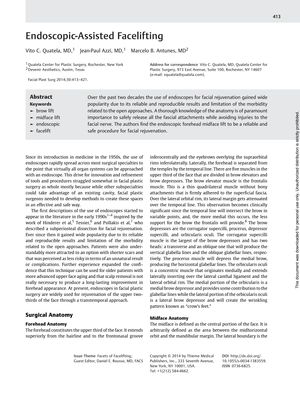Endoscopic-Assisted Facelifting
July 2014
in “
Facial Plastic Surgery
”

TLDR Endoscopic-assisted facelifting is safe and effective with minimal complications and excellent long-term results.
The document from 2014 reviews the technique of endoscopic-assisted facelifting, highlighting its safety, effectiveness, and lower morbidity compared to open facelift procedures. It emphasizes the importance of understanding facial anatomy to avoid facial nerve injury and details the surgical approach for rejuvenating the forehead and midface. The procedure involves careful incisions, subperiosteal dissection, and suture suspension, with screws used for fixation that are typically removed 7 to 10 days postoperatively. The safety profile is notable, with a revision surgery rate of less than 1%, a temporary neuropraxia rate of about 1%, and an extremely rare incidence of permanent nerve paresis (1 in over 1,000 cases). Other complications such as hematoma and infection are also very low, at less than 1% and about 0.1% respectively, and temporary hair loss around incisions occurs in about 5% of patients. The authors conclude that endoscopic-assisted facelifting provides excellent long-term results with minimal complications.